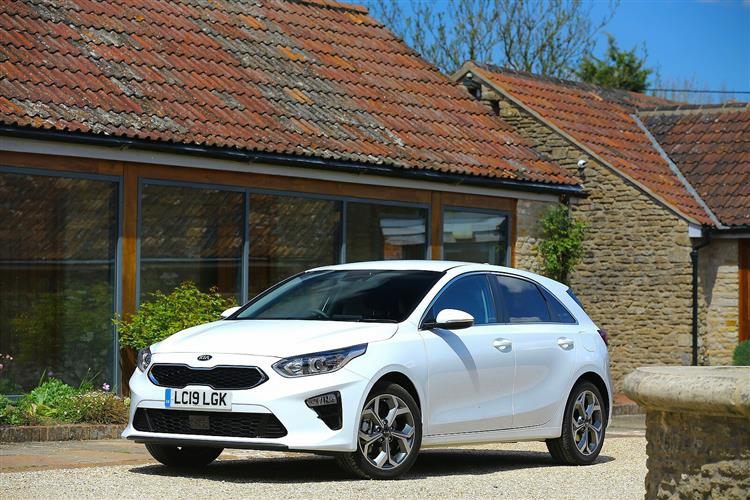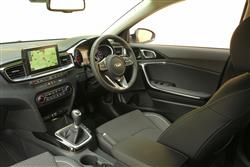CEED INVESTMENT (some text hidden) SECTIONED_new_kiaceed_2018
By Jonathan Crouch
Introductionword count: 79
In its third generation guise, Kia's Ceed further sharpened its proposition in the Focus-class family hatchback segment, with smarter looks, extra technology, a rejuvenated range of engines, stronger standards of safety and, most importantly, a far more dynamic driving demeanour. As before, value continued as a strong suit and as usual, there was an industry-leading warranty. Potentially then, there's a lot to like here for the used buyer. Here, we look at the original 2018-2021-era versions of this model.
Modelsword count: 16
5dr hatch / SW Estate (1.0 T-GDI, 1.4 T-GDi, 1.6 CRDi [1, SR7, 2, 3, GT])
Historyword count: 507
If you want to better appreciate just why Kia is one of the world's fastest growing automotive brands, you've only to look at the Ceed family hatchback. The Slovakian factory that builds it only opened its doors in 2006 yet by 2018, over 1.3 million Ceed models had been built. It was the task of this more stylish, dynamically able third generation version to try and ensure that this momentum continued. Automotive historians will look back at the original first generation version of this car, launched in 2006, as a landmark design, the first to take on the European and Japanese market leaders squarely on their own terms in the volume Focus and Golf-dominated Family Hatchback sector. Built in the heart of Europe, it was targeted at the heart of the European motor industry, hence the unusual 'Ceed' name, a combination of the French abbreviation for European Community (CE) and this car's project title (ED). It shamed the established players by matching their quality while massively undercutting their prices and offering an astonishingly long 7-year warranty. A strong sales performance followed, kick-starting this Korean brand's emergence as a motor industry force to be reckoned with. That's been one of the enduring industrial stories of the early part of the 21st century, right up there with Google, Apple and Facebook - and every bit as impressive. But times change - and so do market segments. Increasingly, family hatchback buyers are being tempted away into Qashqai-like family SUV models, while the customers in this sector that remain are targeted by European and Japanese brands that have now learned to take the Korean motor industry a lot more seriously. Kia, of course, has responded to this. Its own mid-sized SUV, the Sportage, is a strong Qashqai-class alternative and the cee'd was re-launched in more sophisticated second generation 'JD'-series form in 2012 and then substantially updated in 2016, before this MK3 range was introduced in mid-2018. The silly apostrophe that previously featured in the cee'd name was dispensed with by 2018, but the relentless attention to detail that characterised the design of those previous models was prioritised just as much. A lot was expected here, for this car throughout its lifetime had to take on all-new versions of its segment's two heaviest hitters, Ford's Focus and Volkswagen's Golf. In response, Kia's used many of the same people who created their sleek, dynamically-performing Stinger GT flagship model to try and transform the rather uninspiring looks and forgettable handling of this car's predecessor. There was an all-new 'K2' platform to undergird it all, along with new engine technology, improved connectivity and a big step forward in camera-driven safety provision. Plus, for those not wanting the straightforward five-door hatch body style, there's the option of a stylish new 'shooting brake'-style station wagon-like body shape bearing the 'Proceed' name, along with the usual conventional Sportswagon estate variant and a potent GT hot hatch. The Ceed sold in this form until mid-2021, when it was significantly facelifted. It's the pre-facelift 2018-2021-era models we look at here.
What You Getword count: 345
You could say that it's relatively easy for Kia to showcase its new-found sense of style on low volume halo models like the Stinger. A mainstream family contender like this one is a sterner test of the brand's commitment to cutting-edge aesthetics, a policy presided over by design chiefs Peter Schreyer and Gregory Guillaume. What they served up here falls short of being truly arresting, but it was a useful evolution over the previous model, being lower and wider than the car it replaced. In terms of upgraded looks, most of the effort went into the front, with its wider 'tiger nose' grille and lower air intake. From the side, you get more of a perspective for the bolder, more horizontal shoulder line, something even more evident on the alternative Sportswagon estate version of this model. At the wheel, you get higher standards of cabin quality than with previous Ceeds and a more horizontally-orientated fascia gives the cabin an airier, more spacious feel. It's split into two sections; a lower area, housing controls for audio, heating and ventilation. And an upper region, dominated by a centre colour touchscreen, available in either 7 or 8-inch sizes and offered with the usual smartphone-mirroring features. Getting comfortable is easy, thanks to plenty of seat and wheel adjustment, along with lots of cabin storage space. A smart three-spoke wheel feels good to hold and through it, you view a clearly-designated instrument cluster with an informative centre screen In the back. Kia claimed a 34mm increase in shoulder room - there's a class-leading 1,406mm of it. That, along with the notable low centre transmission tunnel, means that a Ceed can in this form more comfortably accommodate three rear adults than most of its segment rivals. And the boot. There's 395-litres on offer here, around 15-litres more than you'd get from either the previous generation Ceed or from a class favourite like a Golf or a Focus. Opt for the stylised Proceed shooting brake model and the luggage area size grows to 594-litres, while on the boxier Sportwagon estate, it's 625-litres.
To see the full road test text contact us on 0330 0020 227
Pictures (high res disabled)

.jpg)
|
.jpg)
|
.jpg)
| |||
.jpg)
|
.jpg)
|
.jpg)
| |||
.jpg)
|
.jpg)
|
.jpg)
| |||

|
Scoring (subset of scores)
Category: Compact Family Cars
| Performance | |
| Handling | |
| Comfort | |
| Space | |
| Styling, Build, Value, Equipment, Depreciation, Handling, Insurance and Total scores are available with our full data feed. | |



